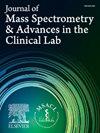血清胆甾烷酸(C27)的串联质谱法--典型浓度范围及在过氧化物酶体生物生成紊乱研究中的应用
IF 3.4
4区 医学
Q2 MEDICAL LABORATORY TECHNOLOGY
Journal of Mass Spectrometry and Advances in the Clinical Lab
Pub Date : 2024-11-01
DOI:10.1016/j.jmsacl.2024.10.005
引用次数: 0
摘要
背景过氧化物酶体失调时初级胆汁酸合成受损,导致长链胆汁酸积累,特别是二羟基胆甾烷酸和三羟基胆甾烷酸。方法采用高效液相色谱电喷雾离子化-串联质谱法和稳定同位素稀释法对血清中胆汁酸的所有八种非对映异构体进行定量分析。结果该测定在 20-2,500 纳克/毫升范围内呈线性关系,测定内和测定间的不精密度为 CV 值的 20%。20 名成人对照组血清中总 C27 胆汁酸的平均(±SEM)浓度较低(0.007 ± 0.004 μmol/L)。在非胆汁淤积型、中度胆汁淤积型和重度胆汁淤积型患者中,总 C27 胆汁酸的浓度分别为 0.015 ± 0.011、0.129 ± 0.034 和 0.986 ± 0.249 μmol/L。相比之下,确诊为过氧化物酶体紊乱的患者(n = 49)的浓度高出 10 倍(14.06 ± 2.59 μmol/L)。PEX基因发生杂合突变的患者血清中C27胆汁酸的浓度较低。在所有组别中,(25S)-和(25R)-非对映异构体的比例均为 0.3。在 2-甲基乙酰-CoA消旋酶缺乏症病例中,血清中 C27 胆汁酸总量明显升高(10.61 ± 0.92 μmol/L),且完全由 (25R)- 非对映异构体组成。该方法适用于过氧物酶体疾病的诊断,并能将2-甲基酰-CoA外消旋酶缺乏症与其他过氧物酶体生物生成疾病区分开来。本文章由计算机程序翻译,如有差异,请以英文原文为准。
Tandem mass spectrometry of serum cholestanoic (C27) acids – Typical concentration ranges and application to the study of peroxisomal biogenesis disorders
Background
Primary bile acid synthesis is impaired in peroxisomal disorders, leading to the accumulation of long-chain bile acids, specifically dihydroxycholestanoic and trihydroxycholestanoic acids. Quantification of the diastereoisomers of these C27 bile acids is essential for the differential diagnosis of these disorders.
Methods
High-performance liquid chromatography electrospray ionization-tandem mass spectrometry with stable-isotope dilution was used to quantify all eight diastereoisomers of cholestanoic acids in serum. Clinical ranges were established for patients with and without cholestatic liver disease, as well as for those with peroxisomal disorders.
Results
The assay was linear over the range of 20–2,500 ng/mL, and intra- and inter-assay imprecision was <20 % CV. The mean (±SEM) serum concentration of total C27 bile acids in 20 adult controls was low (0.007 ± 0.004 μmol/L). In non-cholestatic, moderately cholestatic, and severely cholestatic patients, total C27 bile acids measured 0.015 ± 0.011, 0.129 ± 0.034, and 0.986 ± 0.249 μmol/L, respectively. In contrast, patients with confirmed peroxisomal disorders (n = 49) exhibited concentrations >10-fold higher (14.06 ± 2.59 μmol/L). Patients with heterozygous mutations in PEX genes had low concentrations of serum C27 bile acids. In all groups, the (25S)- and (25R)-diastereomers were present in a ratio of 0.3. In cases of 2-methylacyl-CoA racemase deficiency, serum total C27 bile acids were markedly elevated (10.61 ± 0.92 μmol/L) and comprised exclusively the (25R)-diastereoisomer.
Conclusions
This tandem mass spectrometric assay quantifies all diastereoisomers of the C27 cholestanoic acids in serum and was used to establish typical clinical concentration ranges. The method is applicable to the diagnosis of peroxisomal disorders and differentiates 2-methylacyl-CoA racemase deficiency from other peroxisomal biogenesis disorders.
求助全文
通过发布文献求助,成功后即可免费获取论文全文。
去求助
来源期刊

Journal of Mass Spectrometry and Advances in the Clinical Lab
Health Professions-Medical Laboratory Technology
CiteScore
4.30
自引率
18.20%
发文量
41
审稿时长
81 days
 求助内容:
求助内容: 应助结果提醒方式:
应助结果提醒方式:


